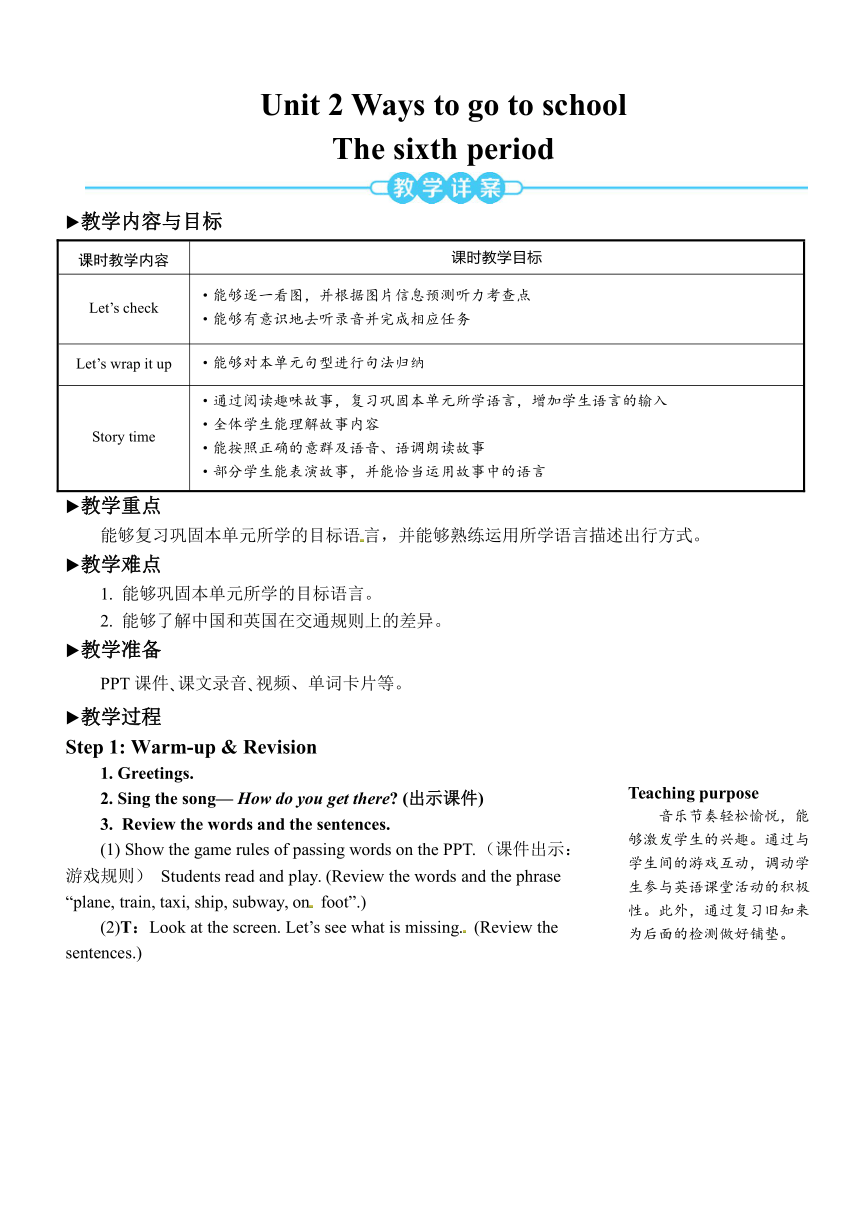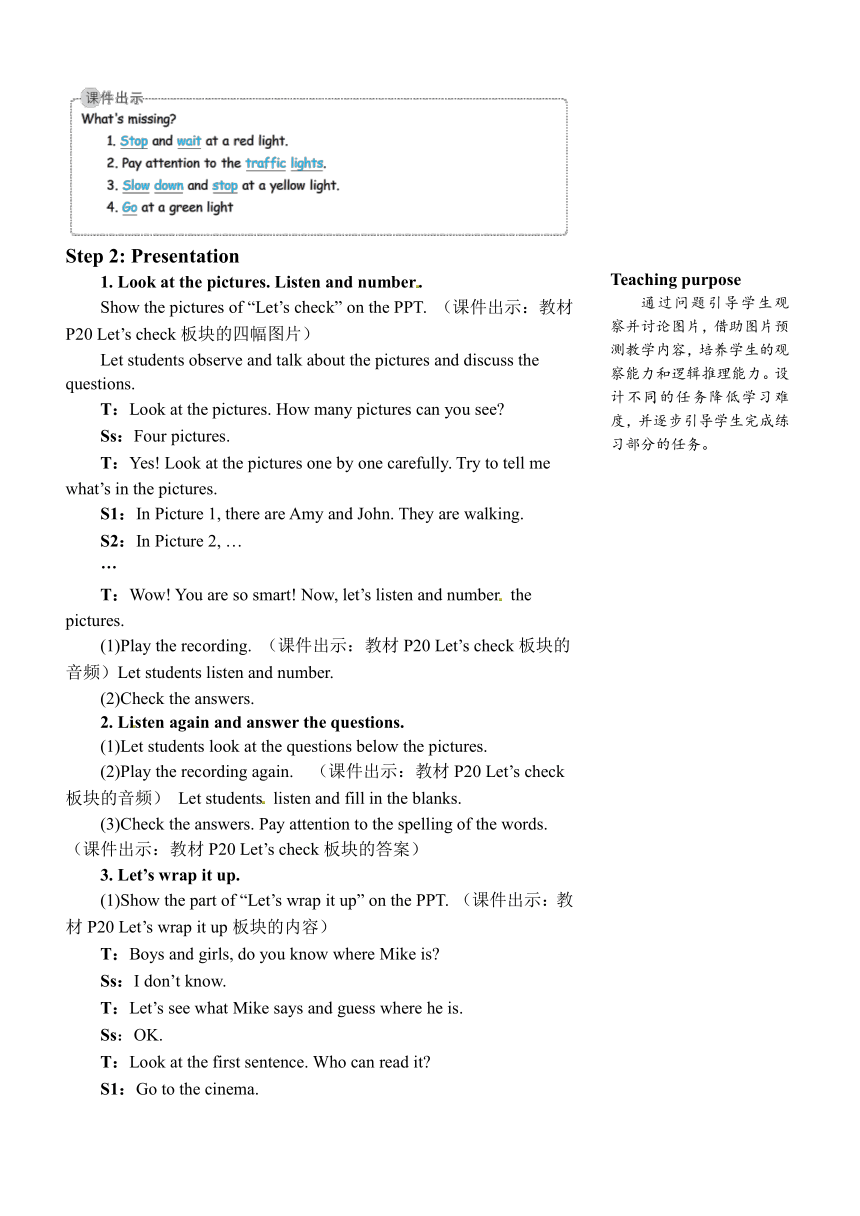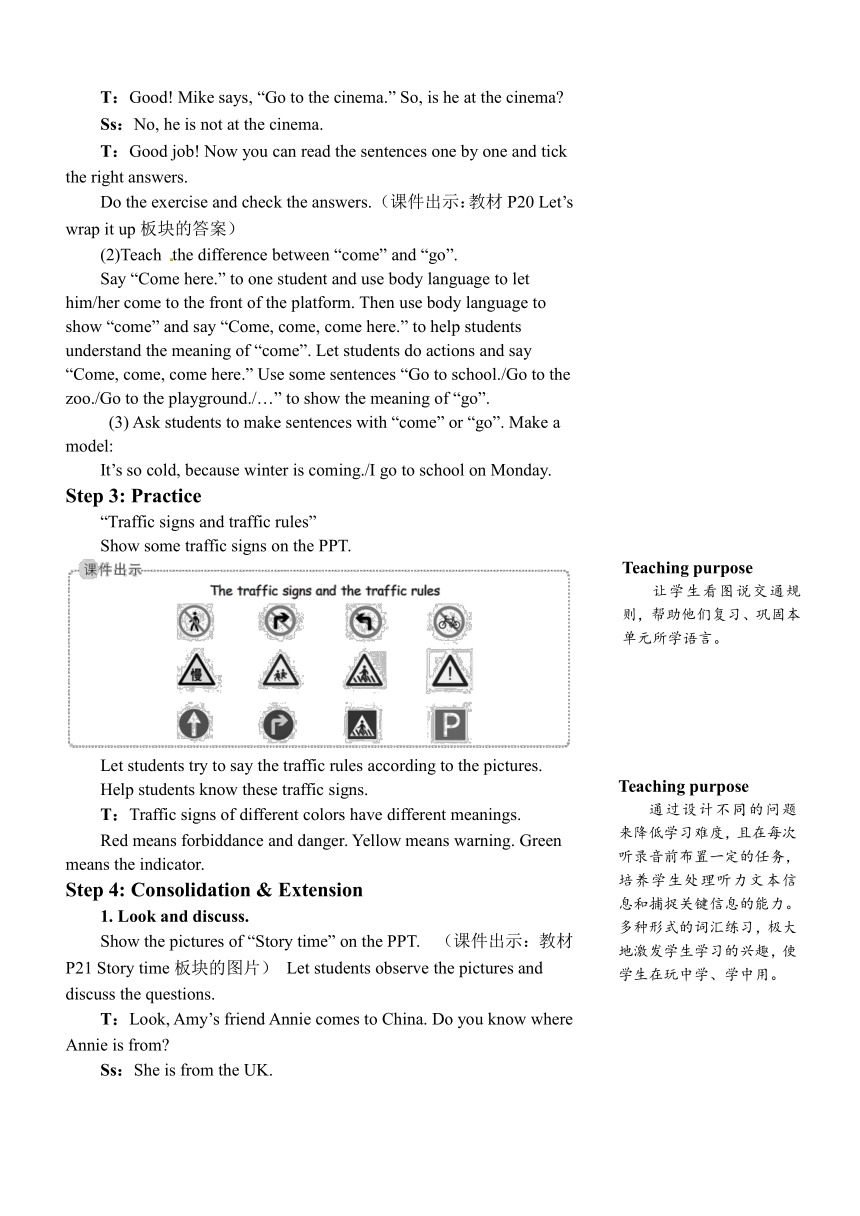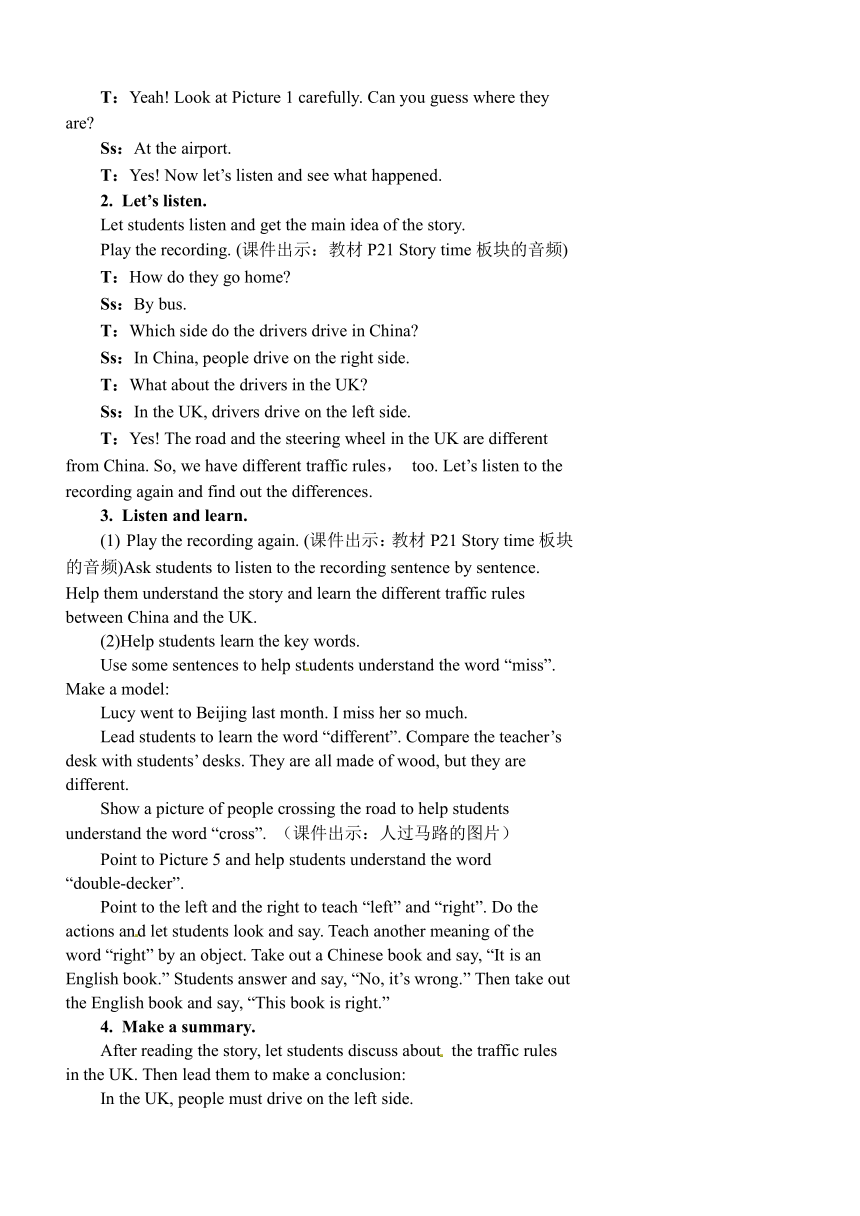Unit 2 Ways to go to school Part B Let’s check & Let’s wrap it up & Part C Story time教案(含反思,详案与简案)
文档属性
| 名称 | Unit 2 Ways to go to school Part B Let’s check & Let’s wrap it up & Part C Story time教案(含反思,详案与简案) |  | |
| 格式 | zip | ||
| 文件大小 | 440.3KB | ||
| 资源类型 | 教案 | ||
| 版本资源 | 人教版(PEP) | ||
| 科目 | 英语 | ||
| 更新时间 | 2020-06-12 14:24:34 | ||
图片预览




文档简介
Unit
2
Ways
to
go
to
school
The
sixth
period
?教学内容与目标
课时教学内容
课时教学目标
Let’s
check
·能够逐一看图,并根据图片信息预测听力考查点·能够有意识地去听录音并完成相应任务
Let’s
wrap
it
up
·能够对本单元句型进行句法归纳
Story
time
·通过阅读趣味故事,复习巩固本单元所学语言,增加学生语言的输入·全体学生能理解故事内容·能按照正确的意群及语音、语调朗读故事·部分学生能表演故事,并能恰当运用故事中的语言
?教学重点
能够复习巩固本单元所学的目标语言,并能够熟练运用所学语言描述出行方式。
?教学难点
能够巩固本单元所学的目标语言。
能够了解中国和英国在交通规则上的差异。
?教学准备
PPT课件?课文录音?视频、单词卡片等。
?教学过程
Step
1:
Warm-up
&
Revision
1.
Greetings.
2.
Sing
the
song—
How
do
you
get
there?
(出示课件)
Review
the
words
and
the
sentences.
(1)
Show
the
game
rules
of
passing
words
on
the
PPT.
(课件出示:游戏规则)
Students
read
and
play.
(Review
the
words
and
the
phrase
“plane,
train,
taxi,
ship,
subway,
on
foot”.)
(2)T:Look
at
the
screen.
Let’s
see
what
is
missing.
(Review
the
sentences.)
Step
2:
Presentation
1.
Look
at
the
pictures.
Listen
and
number.
Show
the
pictures
of
“Let’s
check”
on
the
PPT.
(课件出示:教材P20
Let’s
check板块的四幅图片)
Let
students
observe
and
talk
about
the
pictures
and
discuss
the
questions.
T:Look
at
the
pictures.
How
many
pictures
can
you
see?
Ss:Four
pictures.
T:Yes!
Look
at
the
pictures
one
by
one
carefully.
Try
to
tell
me
what’s
in
the
pictures.
S1:In
Picture
1,
there
are
Amy
and
John.
They
are
walking.
S2:In
Picture
2,
…
…
T:Wow!
You
are
so
smart!
Now,
let’s
listen
and
number
the
pictures.
(1)Play
the
recording.
(课件出示:教材P20
Let’s
check板块的音频)Let
students
listen
and
number.
(2)Check
the
answers.
2.
Listen
again
and
answer
the
questions.
(1)Let
students
look
at
the
questions
below
the
pictures.
(2)Play
the
recording
again.
(课件出示:教材P20
Let’s
check板块的音频)
Let
students
listen
and
fill
in
the
blanks.
(3)Check
the
answers.
Pay
attention
to
the
spelling
of
the
words.
(课件出示:教材P20
Let’s
check板块的答案)
3.
Let’s
wrap
it
up.
(1)Show
the
part
of
“Let’s
wrap
it
up”
on
the
PPT.
(课件出示:教材P20
Let’s
wrap
it
up板块的内容)
T:Boys
and
girls,
do
you
know
where
Mike
is?
Ss:I
don’t
know.[来源:Zxxk.Com]
T:Let’s
see
what
Mike
says
and
guess
where
he
is.
Ss:OK.
T:Look
at
the
first
sentence.
Who
can
read
it?
S1:Go
to
the
cinema.
T:Good!
Mike
says,
“Go
to
the
cinema.”
So,
is
he
at
the
cinema?
Ss:No,
he
is
not
at
the
cinema.
T:Good
job!
Now
you
can
read
the
sentences
one
by
one
and
tick
the
right
answers.
Do
the
exercise
and
check
the
answers.
(课件出示:教材P20
Let’s
wrap
it
up板块的答案)
(2)Teach
the
difference
between
“come”
and
“go”.
Say
“Come
here.”
to
one
student
and
use
body
language
to
let
him/her
come
to
the
front
of
the
platform.
Then
use
body
language
to
show
“come”
and
say
“Come,
come,
come
here.”
to
help
students
understand
the
meaning
of
“come”.
Let
students
do
actions
and
say
“Come,
come,
come
here.”
Use
some
sentences
“Go
to
school./Go
to
the
zoo./Go
to
the
playground./…”
to
show
the
meaning
of
“go”.
(3)
Ask
students
to
make
sentences
with
“come”
or
“go”.
Make
a
model:
It’s
so
cold,
because
winter
is
coming./I
go
to
school
on
Monday.
Step
3:
Practice
“Traffic
signs
and
traffic
rules”
Show
some
traffic
signs
on
the
PPT.
Let
students
try
to
say
the
traffic
rules
according
to
the
pictures.
Help
students
know
these
traffic
signs.
T:Traffic
signs
of
different
colors
have
different
meanings.[来源:学科网ZXXK]
Red
means
forbiddance
and
danger.
Yellow
means
warning.
Green
means
the
indicator.
Step
4:
Consolidation
&
Extension
1.
Look
and
discuss.
Show
the
pictures
of
“Story
time”
on
the
PPT.
(课件出示:教材P21
Story
time板块的图片)
Let
students
observe
the
pictures
and
discuss
the
questions.
T:Look,
Amy’s
friend
Annie
comes
to
China.
Do
you
know
where
Annie
is
from?
Ss:She
is
from
the
UK.
T:Yeah!
Look
at
Picture
1
carefully.
Can
you
guess
where
they
are?
Ss:At
the
airport.
T:Yes!
Now
let’s
listen
and
see
what
happened.
Let’s
listen.
Let
students
listen
and
get
the
main
idea
of
the
story.
Play
the
recording.
(课件出示:教材P21
Story
time板块的音频)
T:How
do
they
go
home?
Ss:By
bus.
T:Which
side
do
the
drivers
drive
in
China?
Ss:In
China,
people
drive
on
the
right
side.
T:What
about
the
drivers
in
the
UK?
Ss:In
the
UK,
drivers
drive
on
the
left
side.
T:Yes!
The
road
and
the
steering
wheel
in
the
UK
are
different
from
China.
So,
we
have
different
traffic
rules,
too.
Let’s
listen
to
the
recording
again
and
find
out
the
differences.
Listen
and
learn.
Play
the
recording
again.
(课件出示:教材P21
Story
time板块的音频)Ask
students
to
listen
to
the
recording
sentence
by
sentence.
Help
them
understand
the
story
and
learn
the
different
traffic
rules
between
China
and
the
UK.
(2)Help
students
learn
the
key
words.
Use
some
sentences
to
help
students
understand
the
word
“miss”.
Make
a
model:
Lucy
went
to
Beijing
last
month.
I
miss
her
so
much.
Lead
students
to
learn
the
word
“different”.
Compare
the
teacher’s
desk
with
students’
desks.
They
are
all
made
of
wood,
but
they
are
different.
Show
a
picture
of
people
crossing
the
road
to
help
students
understand
the
word
“cross”.
(课件出示:人过马路的图片)
Point
to
Picture
5
and
help
students
understand
the
word
“double-decker”.
Point
to
the
left
and
the
right
to
teach
“left”
and
“right”.
Do
the
actions
and
let
students
look
and
say.
Teach
another
meaning
of
the
word
“right”
by
an
object.
Take
out
a
Chinese
book
and
say,
“It
is
an
English
book.”
Students
answer
and
say,
“No,
it’s
wrong.”
Then
take
out
the
English
book
and
say,
“This
book
is
right.”
Make
a
summary.
After
reading
the
story,
let
students
discuss
about
the
traffic
rules
in
the
UK.
Then
lead
them
to
make
a
conclusion:
In
the
UK,
people
must
drive
on
the
left
side.
In
China,
people
must
drive
on
the
right
side.
In
the
UK,
people
must…[来源:学§科§网Z§X§X§K]
In
China,
people
must…
Let’s
read.
[来源:学科网ZXXK]
Play
the
recording
for
the
third
time.
(课件出示:教材P21
Story
time板块的音频)
Let
students
read
after
the
recording
and
pay
attention
to
the
pronunciation
and
the
intonation.
Act
out.
Let
students
read
the
story
in
roles.
Then
lead
them
to
act
out.
?板书设计
?教学反思[来源:学§科§网Z§X§X§K]
在本堂课中,以学生为主体、训练为主线,开展多类型的小组活动,使学生在学中用、用中学。学用结合,激发学生的多元智能学习能力。
这节课以复习巩固为主,配以简单的习题检测和情景故事来运用所学句型。采用传递词汇、填词游戏等多种形式来逐步引导学生操练词汇、句型,有效地帮助学生巩固重点词汇和句型。
呈现活动设计丰富,易操作,且具备层次感,有效地提升了学生的核心素养。以学生为本,以解决问题为导向,引导学生自主学习。
突出语用功能,联系学生和班级的实际情况,设置多个环节,环环相扣,层层深入,帮助学生在真实情景中自然地使用所学语言。
通过设计不同的问题来降低学习难度,且在每次听录音前布置一定的任务,培养学生处理听力文本信息和捕捉关键信息的能力。多种形式的词汇练习,极大地激发了学生学习的兴趣,使学生在玩中学、学中用。
?Teaching
Contents
&
Teaching
Aims
Let’s
check
·Be
able
to
predict
the
examination
points
of
listening
by
observing
the
pictures
one
by
one.
·Be
able
to
understand
the
recording,
then
number
the
pictures
and
answer
the
questions.
Let’s
wrap
it
up
·Be
able
to
summarize
the
sentence
structures
of
this
unit.
Story
time
·Review
and
consolidate
the
target
language
learned
in
this
unit
and
increase
the
input
of
students
by
reading
the
interesting
story.
·Be
able
to
understand
the
story
for
all
students.
·Be
able
to
read
the
story
with
correct
pronunciation
and
intonation
and
sense
groups.
·Be
able
to
act
out
the
story
and
use
the
language
in
the
story
properly
for
a
part
of
students.
?Teaching
Priorities
·Be
able
to
review
and
consolidate
the
target
language
learned
in
this
unit
and
be
able
to
use
the
language
to
describe
the
ways
of
traveling.
?Teaching
Difficulties
·Be
able
to
consolidate
the
target
language
of
this
unit.
·Be
able
to
understand
the
differences
between
China
and
the
UK
in
traffic
rules.
?Teaching
Procedures
Teaching
Stages
Teacher’
s
Activities
Students
Activities
Teaching
Purposes
Warm-up&Revision
1.
Greetings.2.
Sing
the
song—How
do
you
get
there?3.
Review
the
words
and
the
sentences.
1.
Greetings.2.
Sing
the
song.3.
Review
the
words
and
the
sentences.
Stimulate
students’
interest
in
learning
and
motivate
students
to
participate
in
the
activities
in
class.Review
old
knowledge
to
pave
the
way
for
later
tasks.
Presentation
1.
Look
at
the
pictures.
Listen
and
number.2.
Listen
again
and
answer
the
questions.3.
Let’s
wrap
it
up.
(1)Ask
students
to
do
the
exercises
and
check
the
answers.(2)Teach
the
difference
between
“come”
and
“go”.(3)Ask
students
to
make
sentences
with
“come”
or
“go”.
1.
Observe
and
talk
about
the
pictures
and
discuss
the
questions.
Listen
and
number
the
pictures.2.
Listen
and
fill
in
the
blanks.
Check
the
answers.3.
(1)Do
the
exercises
and
check
the
answers.(2)Learn
the
difference
between
“come”
and
“go”.
(3)Make
sentences
with
“come”
or
“go”.
Lead
students
to
predict
the
content
before
listening
to
the
recording.
Cultivate
students’
observation
ability
and
logical
reasoning
ability.
Design
different
tasks
to
reduce
the
difficulty
of
learning.
Practice
“Traffic
signs
and
traffic
rules”Show
some
traffic
signs
on
the
PPT.Ask
students
to
try
to
say
the
traffic
rules
according
to
the
pictures.Help
students
know
these
traffic
signs.
Look
at
the
traffic
signs
and
try
to
say
the
traffic
rules
according
to
the
pictures.
Know
these
traffic
signs.
Review
and
consolidate
the
language
learned
in
this
unit.
(续表)
Teaching
Stages
Teacher’
s
Activities
Students’
Activities
Teaching
Purposes
Consolidation&Extension
1.
Look
at
the
pictures
and
discuss
the
questions.2.
Let's
listen.3.
Listen
and
learn.
Play
the
recording
again.
Lead
students
to
learn
the
different
traffic
rules
between
China
and
the
UK.4.
Make
a
summary.5.
Let’s
read.6.
Act
out.
1.
Look
at
the
picture
and
discuss
the
questions.2.
Listen
and
get
the
main
idea
of
the
story.3.
Listen
to
the
recording
sentence
by
sentence.
Understand
the
story.Learn
the
key
words.4.
Discuss
about
the
traffic
rules
in
the
UK.
And
make
a
conclusion.5.
Read
after
the
recording.
Pay
attention
to
the
pronunciation
and
the
intonation.6.
Read
the
story
in
roles.Act
out
the
story.
Help
students
understand
the
story.
Make
sure
some
students
read
the
story
correctly
and
fluently.
Stimulate
students’
interest
in
learning.
Develop
students’
ability
to
process
the
listening
text
and
capture
key
information.
Homework
Enjoy
the
story.Do
the
exercises.
Teaching
purpose
音乐节奏轻松愉悦,能够激发学生的兴趣。通过与学生间的游戏互动,调动学生参与英语课堂活动的积极性。此外,通过复习旧知来为后面的检测做好铺垫。
Teaching
purpose
通过问题引导学生观察并讨论图片,借助图片预测教学内容,培养学生的观察能力和逻辑推理能力。设计不同的任务降低学习难度,并逐步引导学生完成练习部分的任务。
Teaching
purpose
让学生看图说交通规则,帮助他们复习、巩固本单元所学语言。
Teaching
purpose
通过设计不同的问题来降低学习难度,且在每次听录音前布置一定的任务,培养学生处理听力文本信息和捕捉关键信息的能力。多种形式的词汇练习,极大地激发学生学习的兴趣,使学生在玩中学、学中用。
2
Ways
to
go
to
school
The
sixth
period
?教学内容与目标
课时教学内容
课时教学目标
Let’s
check
·能够逐一看图,并根据图片信息预测听力考查点·能够有意识地去听录音并完成相应任务
Let’s
wrap
it
up
·能够对本单元句型进行句法归纳
Story
time
·通过阅读趣味故事,复习巩固本单元所学语言,增加学生语言的输入·全体学生能理解故事内容·能按照正确的意群及语音、语调朗读故事·部分学生能表演故事,并能恰当运用故事中的语言
?教学重点
能够复习巩固本单元所学的目标语言,并能够熟练运用所学语言描述出行方式。
?教学难点
能够巩固本单元所学的目标语言。
能够了解中国和英国在交通规则上的差异。
?教学准备
PPT课件?课文录音?视频、单词卡片等。
?教学过程
Step
1:
Warm-up
&
Revision
1.
Greetings.
2.
Sing
the
song—
How
do
you
get
there?
(出示课件)
Review
the
words
and
the
sentences.
(1)
Show
the
game
rules
of
passing
words
on
the
PPT.
(课件出示:游戏规则)
Students
read
and
play.
(Review
the
words
and
the
phrase
“plane,
train,
taxi,
ship,
subway,
on
foot”.)
(2)T:Look
at
the
screen.
Let’s
see
what
is
missing.
(Review
the
sentences.)
Step
2:
Presentation
1.
Look
at
the
pictures.
Listen
and
number.
Show
the
pictures
of
“Let’s
check”
on
the
PPT.
(课件出示:教材P20
Let’s
check板块的四幅图片)
Let
students
observe
and
talk
about
the
pictures
and
discuss
the
questions.
T:Look
at
the
pictures.
How
many
pictures
can
you
see?
Ss:Four
pictures.
T:Yes!
Look
at
the
pictures
one
by
one
carefully.
Try
to
tell
me
what’s
in
the
pictures.
S1:In
Picture
1,
there
are
Amy
and
John.
They
are
walking.
S2:In
Picture
2,
…
…
T:Wow!
You
are
so
smart!
Now,
let’s
listen
and
number
the
pictures.
(1)Play
the
recording.
(课件出示:教材P20
Let’s
check板块的音频)Let
students
listen
and
number.
(2)Check
the
answers.
2.
Listen
again
and
answer
the
questions.
(1)Let
students
look
at
the
questions
below
the
pictures.
(2)Play
the
recording
again.
(课件出示:教材P20
Let’s
check板块的音频)
Let
students
listen
and
fill
in
the
blanks.
(3)Check
the
answers.
Pay
attention
to
the
spelling
of
the
words.
(课件出示:教材P20
Let’s
check板块的答案)
3.
Let’s
wrap
it
up.
(1)Show
the
part
of
“Let’s
wrap
it
up”
on
the
PPT.
(课件出示:教材P20
Let’s
wrap
it
up板块的内容)
T:Boys
and
girls,
do
you
know
where
Mike
is?
Ss:I
don’t
know.[来源:Zxxk.Com]
T:Let’s
see
what
Mike
says
and
guess
where
he
is.
Ss:OK.
T:Look
at
the
first
sentence.
Who
can
read
it?
S1:Go
to
the
cinema.
T:Good!
Mike
says,
“Go
to
the
cinema.”
So,
is
he
at
the
cinema?
Ss:No,
he
is
not
at
the
cinema.
T:Good
job!
Now
you
can
read
the
sentences
one
by
one
and
tick
the
right
answers.
Do
the
exercise
and
check
the
answers.
(课件出示:教材P20
Let’s
wrap
it
up板块的答案)
(2)Teach
the
difference
between
“come”
and
“go”.
Say
“Come
here.”
to
one
student
and
use
body
language
to
let
him/her
come
to
the
front
of
the
platform.
Then
use
body
language
to
show
“come”
and
say
“Come,
come,
come
here.”
to
help
students
understand
the
meaning
of
“come”.
Let
students
do
actions
and
say
“Come,
come,
come
here.”
Use
some
sentences
“Go
to
school./Go
to
the
zoo./Go
to
the
playground./…”
to
show
the
meaning
of
“go”.
(3)
Ask
students
to
make
sentences
with
“come”
or
“go”.
Make
a
model:
It’s
so
cold,
because
winter
is
coming./I
go
to
school
on
Monday.
Step
3:
Practice
“Traffic
signs
and
traffic
rules”
Show
some
traffic
signs
on
the
PPT.
Let
students
try
to
say
the
traffic
rules
according
to
the
pictures.
Help
students
know
these
traffic
signs.
T:Traffic
signs
of
different
colors
have
different
meanings.[来源:学科网ZXXK]
Red
means
forbiddance
and
danger.
Yellow
means
warning.
Green
means
the
indicator.
Step
4:
Consolidation
&
Extension
1.
Look
and
discuss.
Show
the
pictures
of
“Story
time”
on
the
PPT.
(课件出示:教材P21
Story
time板块的图片)
Let
students
observe
the
pictures
and
discuss
the
questions.
T:Look,
Amy’s
friend
Annie
comes
to
China.
Do
you
know
where
Annie
is
from?
Ss:She
is
from
the
UK.
T:Yeah!
Look
at
Picture
1
carefully.
Can
you
guess
where
they
are?
Ss:At
the
airport.
T:Yes!
Now
let’s
listen
and
see
what
happened.
Let’s
listen.
Let
students
listen
and
get
the
main
idea
of
the
story.
Play
the
recording.
(课件出示:教材P21
Story
time板块的音频)
T:How
do
they
go
home?
Ss:By
bus.
T:Which
side
do
the
drivers
drive
in
China?
Ss:In
China,
people
drive
on
the
right
side.
T:What
about
the
drivers
in
the
UK?
Ss:In
the
UK,
drivers
drive
on
the
left
side.
T:Yes!
The
road
and
the
steering
wheel
in
the
UK
are
different
from
China.
So,
we
have
different
traffic
rules,
too.
Let’s
listen
to
the
recording
again
and
find
out
the
differences.
Listen
and
learn.
Play
the
recording
again.
(课件出示:教材P21
Story
time板块的音频)Ask
students
to
listen
to
the
recording
sentence
by
sentence.
Help
them
understand
the
story
and
learn
the
different
traffic
rules
between
China
and
the
UK.
(2)Help
students
learn
the
key
words.
Use
some
sentences
to
help
students
understand
the
word
“miss”.
Make
a
model:
Lucy
went
to
Beijing
last
month.
I
miss
her
so
much.
Lead
students
to
learn
the
word
“different”.
Compare
the
teacher’s
desk
with
students’
desks.
They
are
all
made
of
wood,
but
they
are
different.
Show
a
picture
of
people
crossing
the
road
to
help
students
understand
the
word
“cross”.
(课件出示:人过马路的图片)
Point
to
Picture
5
and
help
students
understand
the
word
“double-decker”.
Point
to
the
left
and
the
right
to
teach
“left”
and
“right”.
Do
the
actions
and
let
students
look
and
say.
Teach
another
meaning
of
the
word
“right”
by
an
object.
Take
out
a
Chinese
book
and
say,
“It
is
an
English
book.”
Students
answer
and
say,
“No,
it’s
wrong.”
Then
take
out
the
English
book
and
say,
“This
book
is
right.”
Make
a
summary.
After
reading
the
story,
let
students
discuss
about
the
traffic
rules
in
the
UK.
Then
lead
them
to
make
a
conclusion:
In
the
UK,
people
must
drive
on
the
left
side.
In
China,
people
must
drive
on
the
right
side.
In
the
UK,
people
must…[来源:学§科§网Z§X§X§K]
In
China,
people
must…
Let’s
read.
[来源:学科网ZXXK]
Play
the
recording
for
the
third
time.
(课件出示:教材P21
Story
time板块的音频)
Let
students
read
after
the
recording
and
pay
attention
to
the
pronunciation
and
the
intonation.
Act
out.
Let
students
read
the
story
in
roles.
Then
lead
them
to
act
out.
?板书设计
?教学反思[来源:学§科§网Z§X§X§K]
在本堂课中,以学生为主体、训练为主线,开展多类型的小组活动,使学生在学中用、用中学。学用结合,激发学生的多元智能学习能力。
这节课以复习巩固为主,配以简单的习题检测和情景故事来运用所学句型。采用传递词汇、填词游戏等多种形式来逐步引导学生操练词汇、句型,有效地帮助学生巩固重点词汇和句型。
呈现活动设计丰富,易操作,且具备层次感,有效地提升了学生的核心素养。以学生为本,以解决问题为导向,引导学生自主学习。
突出语用功能,联系学生和班级的实际情况,设置多个环节,环环相扣,层层深入,帮助学生在真实情景中自然地使用所学语言。
通过设计不同的问题来降低学习难度,且在每次听录音前布置一定的任务,培养学生处理听力文本信息和捕捉关键信息的能力。多种形式的词汇练习,极大地激发了学生学习的兴趣,使学生在玩中学、学中用。
?Teaching
Contents
&
Teaching
Aims
Let’s
check
·Be
able
to
predict
the
examination
points
of
listening
by
observing
the
pictures
one
by
one.
·Be
able
to
understand
the
recording,
then
number
the
pictures
and
answer
the
questions.
Let’s
wrap
it
up
·Be
able
to
summarize
the
sentence
structures
of
this
unit.
Story
time
·Review
and
consolidate
the
target
language
learned
in
this
unit
and
increase
the
input
of
students
by
reading
the
interesting
story.
·Be
able
to
understand
the
story
for
all
students.
·Be
able
to
read
the
story
with
correct
pronunciation
and
intonation
and
sense
groups.
·Be
able
to
act
out
the
story
and
use
the
language
in
the
story
properly
for
a
part
of
students.
?Teaching
Priorities
·Be
able
to
review
and
consolidate
the
target
language
learned
in
this
unit
and
be
able
to
use
the
language
to
describe
the
ways
of
traveling.
?Teaching
Difficulties
·Be
able
to
consolidate
the
target
language
of
this
unit.
·Be
able
to
understand
the
differences
between
China
and
the
UK
in
traffic
rules.
?Teaching
Procedures
Teaching
Stages
Teacher’
s
Activities
Students
Activities
Teaching
Purposes
Warm-up&Revision
1.
Greetings.2.
Sing
the
song—How
do
you
get
there?3.
Review
the
words
and
the
sentences.
1.
Greetings.2.
Sing
the
song.3.
Review
the
words
and
the
sentences.
Stimulate
students’
interest
in
learning
and
motivate
students
to
participate
in
the
activities
in
class.Review
old
knowledge
to
pave
the
way
for
later
tasks.
Presentation
1.
Look
at
the
pictures.
Listen
and
number.2.
Listen
again
and
answer
the
questions.3.
Let’s
wrap
it
up.
(1)Ask
students
to
do
the
exercises
and
check
the
answers.(2)Teach
the
difference
between
“come”
and
“go”.(3)Ask
students
to
make
sentences
with
“come”
or
“go”.
1.
Observe
and
talk
about
the
pictures
and
discuss
the
questions.
Listen
and
number
the
pictures.2.
Listen
and
fill
in
the
blanks.
Check
the
answers.3.
(1)Do
the
exercises
and
check
the
answers.(2)Learn
the
difference
between
“come”
and
“go”.
(3)Make
sentences
with
“come”
or
“go”.
Lead
students
to
predict
the
content
before
listening
to
the
recording.
Cultivate
students’
observation
ability
and
logical
reasoning
ability.
Design
different
tasks
to
reduce
the
difficulty
of
learning.
Practice
“Traffic
signs
and
traffic
rules”Show
some
traffic
signs
on
the
PPT.Ask
students
to
try
to
say
the
traffic
rules
according
to
the
pictures.Help
students
know
these
traffic
signs.
Look
at
the
traffic
signs
and
try
to
say
the
traffic
rules
according
to
the
pictures.
Know
these
traffic
signs.
Review
and
consolidate
the
language
learned
in
this
unit.
(续表)
Teaching
Stages
Teacher’
s
Activities
Students’
Activities
Teaching
Purposes
Consolidation&Extension
1.
Look
at
the
pictures
and
discuss
the
questions.2.
Let's
listen.3.
Listen
and
learn.
Play
the
recording
again.
Lead
students
to
learn
the
different
traffic
rules
between
China
and
the
UK.4.
Make
a
summary.5.
Let’s
read.6.
Act
out.
1.
Look
at
the
picture
and
discuss
the
questions.2.
Listen
and
get
the
main
idea
of
the
story.3.
Listen
to
the
recording
sentence
by
sentence.
Understand
the
story.Learn
the
key
words.4.
Discuss
about
the
traffic
rules
in
the
UK.
And
make
a
conclusion.5.
Read
after
the
recording.
Pay
attention
to
the
pronunciation
and
the
intonation.6.
Read
the
story
in
roles.Act
out
the
story.
Help
students
understand
the
story.
Make
sure
some
students
read
the
story
correctly
and
fluently.
Stimulate
students’
interest
in
learning.
Develop
students’
ability
to
process
the
listening
text
and
capture
key
information.
Homework
Enjoy
the
story.Do
the
exercises.
Teaching
purpose
音乐节奏轻松愉悦,能够激发学生的兴趣。通过与学生间的游戏互动,调动学生参与英语课堂活动的积极性。此外,通过复习旧知来为后面的检测做好铺垫。
Teaching
purpose
通过问题引导学生观察并讨论图片,借助图片预测教学内容,培养学生的观察能力和逻辑推理能力。设计不同的任务降低学习难度,并逐步引导学生完成练习部分的任务。
Teaching
purpose
让学生看图说交通规则,帮助他们复习、巩固本单元所学语言。
Teaching
purpose
通过设计不同的问题来降低学习难度,且在每次听录音前布置一定的任务,培养学生处理听力文本信息和捕捉关键信息的能力。多种形式的词汇练习,极大地激发学生学习的兴趣,使学生在玩中学、学中用。
同课章节目录
